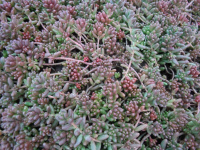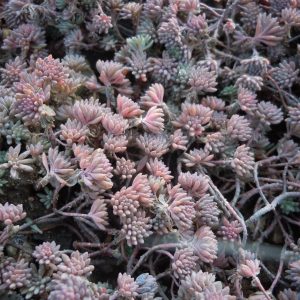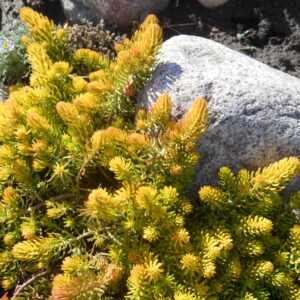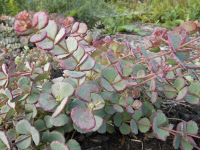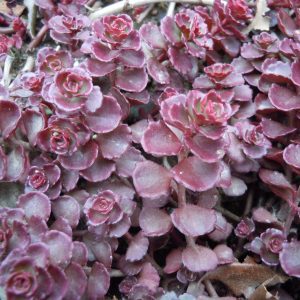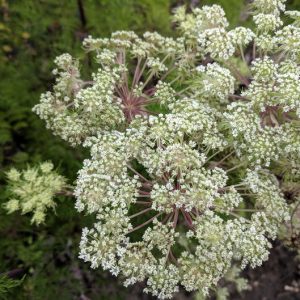Shop
Showing 657–664 of 778 results
-
Scutellaria resinosa syn. Scutellaria wrightii Prairie skullcap Z 4-9
Two-lipped, deep violet-blue tubes bloom from spring to fall
Two-lipped, deep violet-blue tubes bloom from spring to fall
Size: 10” x 10”
Care: sun to part shade in well-drained to moist well-drained soil, drought tolerant
Native: Colorado, NM, KS, Oklahoma, TX, collected on the Canadian River, tributary of Arkansas River
Wildlife Value: deer & rabbit resistant. Nectar and pollen attract butterflies and bees.Described by botanist John Torrey in Annals of the Lyceum of Natural History of NY 2: 232 (1828)
-
Sedum ‘Autumn Joy’ syn ‘Herbstfreude’ syn Hylotelephium ‘Autumn Joy’ Z 4-9
Classic, large flat flower heads turn from green to rose
Classic, large flat flower heads turn from green to rose blooming in September and October. A staple for autumn in the garden.
Size: 30” x 12”
Care: full sun in well-drained soil
Awards: England’s Royal Horticultural Society Award of Garden Merit.Sedum means “plant that sits.” “Live forever” is an ancient Greek name for sedums. The Roman Pliny claimed that sedum’s juice treated wounds. In the 1500’s English herbalist Gerard called sedums “very full of life,” referring to succulent’s quality of being very easy to grow. Autumn Joy introduced to gardens before 1920 by the George Arends Nursery in Ronsdorf, Germany.
-
Sedum album White stonecrop Z 3-8
Clusters of tiny white flowers bloom in mid-summer above succulent, cylindrical foliage.
ARCHIVED
Note: This is a plant not currently for sale. This is an archive page preserved for informational use.
Clusters of tiny white flowers bloom in mid-summer above succulent, cylindrical foliage.
Size: 3-6" x 12-18" spreading making an easy groundcover
Care: sun in moist well-drained to well-drained soil
Native: Europe, Western Asia and Northern Africa
Wildlife Value: Butterflies attracted to flowers, Deer and rabbit resistant.Sedum means “plant that sits.” “Live forever” is an ancient Greek name for sedums. The Roman Pliny claimed that sedum’s juice treated wounds. In the 1500’s English herbalist Gerard called sedums “very full of life,” referring to succulent’s quality of being very easy to grow. This species collected before 1671. It “grows naturally upon old walls in many parts of England.” Gardeners Dictionary, 1768. In 1867 described as “growing, ever so luxuriantly upon roofs and walls (as well as) the rocks at Great Malvern…” Botany of Worcestershire. Landscape designer Andrew Jackson Downing recommended this for edging, 1868.
-
Sedum hispanicum var. minus ‘Purple Form’ Little Blue Spanish stonecrop, Tiny buttons Z 4-9
Many petite faintly pink flowers in June, soft, succulent, glaucous leaves form a perfect mound.
ARCHIVED
Note: This is a plant not currently for sale. This is an archive page preserved for informational use.
Many petite faintly pink flowers in June, soft, succulent, glaucous leaves form a perfect mound. Perfect for rock gardens, front of border, fairy gardens, roof garden, troughs and groundcover, or any place with drought.
Size: 2” x 8”
Care: sun to part sun in well-drained soil
Native: Southern Europe, Balkan peninsulaThe variety minus is considered a synonym of the species which was described by the father of botany, Linnaeus, in 1750’s.
-
Sedum rupestre ‘Angelina’ syn. Sedum reflexum ‘Angelina’ Spruce-leaved stonecrop Z 4-8
Chartreuse, turning red-orange in fall, needle-like leaves blooming with yellow flowers June-August but the leaves are the feature.
Chartreuse, turning red-orange in fall, needle-like leaves blooming with yellow flowers June-August but the leaves are the feature.
Size: 4-6” x 1-2’ spreader
Care: sun in well-drained to moist well-drained soil.
Wildlife Value: Rabbit and Deer resistant. Drought tolerant.Species grown at America’s 1st botanic garden, Elgin Botanic Garden 1811
-
Sedum sieboldii syn Hylotelephium sieboldii, October Daphne Z 3-9
Fleshy gray-green foliage edged with pink encircles the prostrate stems, flowering strawberry pink in fall. Perfect for rock gardens, front of border, fairy gardens, roof gardens, troughs and groundcover or anyplace with drought.
Fleshy gray-green foliage edged with pink encircles the prostrate stems, flowering strawberry pink in fall. Perfect for rock gardens, front of border, fairy gardens, roof gardens, troughs and groundcover or anyplace with drought.
Size: 4" x 8"
Care: full sun in moderately fertile, well-drained soil.
Native: Japan
Wildlife Value: Drought tolerant and deer resistant.
Awards: Elisabeth Carey Miller Botanical Garden Great Plant PickSedum means “plant that sits.” “Live forever” is an ancient Greek name for sedums. The Roman Pliny claimed that sedum’s juice treated wounds. In the 1500’s English herbalist Gerard called sedums “very full of life,” referring to succulent’s quality of being very easy to grow. This species named for its discoverer, Dr. Philipp Franz von Siebold (1791-1866). Von Siebold, a German doctor, worked for the Dutch East India Company as its resident physician on Deshima Island, off the coast of Japan. He boldly became too knowledgeable about Japanese affairs and was imprisoned by the Japanese in 1826 and then banished in 1828. When he left he carried nearly 500 plants with him to Europe. William Robinson, father of the mixed perennial border, described Sedum sieboldii as beautiful. He advised gardeners to grow it “in strong loam and mortar rubble in fully exposed positions (and use it as) an excellent plant for vases in summer.”
-
Sedum spurium ‘Coccineum’ Dragon’s blood Z 4-9
Mat-forming evergreen. In spring red encircle its fleshy, green, round leaves. In summer leaves turn bronze and in fall deep burgundy. Small, bright pink, star-shaped flowers.
Mat-forming evergreen. In spring red encircle its fleshy, green, round leaves. In summer leaves turn bronze and in fall deep burgundy. Small, bright pink, star-shaped flowers.
Size: 4-6" x spreading 12-18"
Care: sun in well-drained to moist well-drained soil
Native: Caucasus Mountains
Awards: Royal Horticultural Society Award of Garden Merit; Great Plant PickFranklin Gardens in Big Springs Arkansas sold this in 1948 for 50 cents calling it “a new sedum. . . “Called “a new Sedum that will surely become popular” New and Noteworthy Hardy Plants Spring Flor-Acres’ Perennials 1950 p. 13
-
Selinum wallichianum syn. S. tenuifolium Milk parsley Z 6-10
All summer filigree of lacy, fern-like foliage then in late summer -fall white domes, 8” across, each dome made of multiple balls atop purple-red stems.
ARCHIVED
Note: This is a plant not currently for sale. This is an archive page preserved for informational use.
“Queen of umbellifers,” EA Bowles. All summer filigree of lacy, fern-like foliage then in late summer -fall white domes, 8” across, each dome made of multiple balls atop purple-red stems.
Size: 3-5’ x 3’
Care: sun to part shade in moist well-drained to well-drained soil
Native: Himalayas
Wildlife Value: butterfly magnet
Awards: recipient of the Royal Horticultural Society Award of Garden MeritOriginally named Cortia lindeyi in 1830 Prodromus Systematis Naturalis Regni Vegetabilis 4: 186. Named for Dutch physician and botanist Nathanial Wallich (1786-1854). Rural Himalayan residents use this for spice, incense and fodder.



